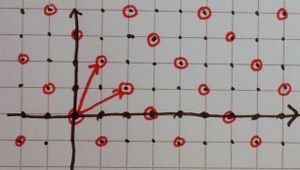Difference between revisions of "Notes:Homology"
From Maths
m (Progress in computing image) |
m (Adding links to new examples) |
||
| Line 1: | Line 1: | ||
| + | * [[/Real projective plane]] | ||
| + | * [[/Torus]] | ||
==Definitions== | ==Definitions== | ||
# '''Boundary operator: ''' {{M|\partial_n:C_n\rightarrow C_{n-1} }} given by {{M|1=\partial_n:[a_0,\ldots a_n]\mapsto\sum^n_{i=0}(-1)^i[a_0,\ldots,\hat{a_i},\ldots,a_n]}} | # '''Boundary operator: ''' {{M|\partial_n:C_n\rightarrow C_{n-1} }} given by {{M|1=\partial_n:[a_0,\ldots a_n]\mapsto\sum^n_{i=0}(-1)^i[a_0,\ldots,\hat{a_i},\ldots,a_n]}} | ||
Latest revision as of 07:30, 15 October 2016
Contents
Definitions
- Boundary operator: [ilmath]\partial_n:C_n\rightarrow C_{n-1} [/ilmath] given by [ilmath]\partial_n:[a_0,\ldots a_n]\mapsto\sum^n_{i=0}(-1)^i[a_0,\ldots,\hat{a_i},\ldots,a_n][/ilmath]
- [ilmath]\mathbf{n} [/ilmath]-cycles: [ilmath]Z_n[/ilmath] (a cycle is defined to have boundary 0, thus [ilmath]Z_n=\text{Ker}(\partial_n)[/ilmath] - todo - discussion)
- [ilmath]\mathbf{n} [/ilmath]-boundaries: [ilmath]B_n[/ilmath] (the image of [ilmath]\partial_{n+1} [/ilmath] - all boundaries)
- Claim: [ilmath]B_n\le Z_n[/ilmath] (that is: [ilmath]B_n[/ilmath] is a subgroup of [ilmath]Z_n[/ilmath])
- [ilmath]\mathbf{n} [/ilmath]th homology group: [ilmath]H_n:=Z_n/B_n[/ilmath]
Examples 1: [ilmath]G_1[/ilmath]
Chain complex: [ilmath]\xymatrix{
0 \ar[r]^{\partial_2} & C_1 \ar[r]^{\partial_1} \ar@2{->}[d] & C_0 \ar[r]^{\partial_0=0} \ar@2{->}[d] & 0 \\
& {\langle a,b,c,d\rangle\cong\mathbb{Z}^4} & {\langle x,y,z\rangle\cong\mathbb{Z}^3}
}[/ilmath]
[ilmath]\partial_1:C_1\rightarrow C_0[/ilmath] morphism:
- We have:
- [ilmath]\partial_1(a)= y-x[/ilmath],
- [ilmath]\partial_1(b)= z-y[/ilmath],
- [ilmath]\partial_1(c)= x-z[/ilmath] and
- [ilmath]\partial_1(d)=x-z[/ilmath] also
- We extend this to a group homomorphism by defining:
- [ilmath]\begin{array}{rcl}\partial_1(\alpha a+\beta b+\gamma c+\delta d)&:=&\alpha\partial_1(a)+\beta\partial_1(b)+\gamma\partial_1(c)+\delta\partial_1(d)\\ & =& \alpha(y-x)+\beta(z-y)+(\gamma+\delta)(x-z)\\& = &(-\alpha+\gamma+\delta)x+(\alpha-\beta)y+(\beta-\gamma-\delta)z\end{array}[/ilmath], we may write: [ilmath]\begin{pmatrix}x\\y\\z\end{pmatrix}=\alpha\left(\begin{array}{c}-1\\ 1 \\ 0\end{array}\right)+\beta\begin{pmatrix}0\\-1\\1\end{pmatrix}+\gamma\begin{pmatrix}1\\0\\-1\end{pmatrix}+\delta\begin{pmatrix}1\\0\\-1\end{pmatrix}=\begin{pmatrix}-1 & 0 & 1 & 1 \\ 1 & -1 & 0 & 0 \\ 0 & 1 & -1 & -1\end{pmatrix}\begin{pmatrix}\alpha\\\beta\\\gamma\\\delta\end{pmatrix}[/ilmath]
- Recall also the rank plus nullity theorem:
- For [ilmath]f\in\mathcal{L}(V,W)[/ilmath] we have [ilmath]\text{Dim}(\text{Ker}(f))+\text{Dim}(\text{Im}(f))=\text{Dim}(V)[/ilmath]
Computing the homology groups:
- [ilmath]H_0:=Z_0/B_0=\text{Ker}(\partial_0)/\text{Im}(\partial_1)[/ilmath]
- Computing [ilmath]\text{Ker}(\partial_0)[/ilmath] (result: [ilmath]\text{Ker}(\partial_0)=C_0[/ilmath])
- By definition, [ilmath]\partial_0:[a_0]\mapsto 0[/ilmath], so everything in the domain of [ilmath]\partial_0[/ilmath] is in the kernel!
- Thus [ilmath]Z_0=C_0[/ilmath]
- Computing [ilmath]\text{Im}(\partial_1)[/ilmath]
- It is clear from the rank plus nullity theorem mentioned above that we should have [ilmath]\text{Dim}(\text{Ker}(\partial_1))+\text{Dim}(\text{Im}(\partial_1))=4[/ilmath] and we'll need to compute the kernel of [ilmath]\partial_1[/ilmath] for [ilmath]H_1[/ilmath] anyway.
- See computing the kernel of [ilmath]\partial_1[/ilmath] below
- The dimension of the kernel is [ilmath]2[/ilmath] so the dimension of the image is [ilmath]2[/ilmath] also!
- [ilmath]H_0=\langle x,y,z\rangle/\langle y-x, z-y\rangle\ (\cong\mathbb{Z}\ ?)[/ilmath] (although surely there are other choices for [ilmath]\langle y-x, z-y\rangle[/ilmath])
- It is clear from the rank plus nullity theorem mentioned above that we should have [ilmath]\text{Dim}(\text{Ker}(\partial_1))+\text{Dim}(\text{Im}(\partial_1))=4[/ilmath] and we'll need to compute the kernel of [ilmath]\partial_1[/ilmath] for [ilmath]H_1[/ilmath] anyway.
- Computing [ilmath]\text{Ker}(\partial_0)[/ilmath] (result: [ilmath]\text{Ker}(\partial_0)=C_0[/ilmath])
- [ilmath]H_1:=Z_1/B_1:=\text{Ker}(\partial_1)/\text{Im}(\partial 2)[/ilmath]
- Computing [ilmath]\text{Ker}(\partial_1)[/ilmath] has already been done below
- Computing [ilmath]\text{Im}(\partial_2)[/ilmath] is easy, it's [ilmath]0[/ilmath] - the trivial group
- Thus:
- [ilmath]H_1\cong\text{Ker}(\partial_1)=\langle a+b+c,a+b+d\rangle\cong\mathbb{Z}^2[/ilmath]
Computing the kernel of [ilmath]\partial_1[/ilmath]
To do this we wish to solve:
- [ilmath]\begin{pmatrix}-1 & 0 & 1 & 1 \\ 1 & -1 & 0 & 0 \\ 0 & 1 & -1 & -1\end{pmatrix}\begin{pmatrix}\alpha\\\beta\\\gamma\\\delta\end{pmatrix}=\begin{pmatrix}0\\0\\0\end{pmatrix}[/ilmath], which basically amounts to rrefing [ilmath]\begin{pmatrix}-1 & 0 & 1 & 1 & 0\\ 1 & -1 & 0 & 0 & 0\\ 0 & 1 & -1 & -1 & 0\end{pmatrix}[/ilmath] giving us [ilmath]\begin{pmatrix}1 & 0 & -1 & -1 & 0\\ 0 & 1 & -1 & -1 & 0 \\ 0 & 0 & 0 & 0 &0\end{pmatrix}[/ilmath]
- Yielding: [ilmath]\alpha=\gamma+\delta[/ilmath] and [ilmath]\beta=\gamma+\delta[/ilmath]. Let [ilmath]\gamma:=s[/ilmath] and then:
- [ilmath]\alpha=s+t[/ilmath] and [ilmath]\beta=s+t[/ilmath], vectorially:
- If [ilmath]\begin{pmatrix}\alpha\\\beta\\\gamma\\\delta\end{pmatrix}=s\begin{pmatrix}1\\1\\1\\0 \end{pmatrix}+t\begin{pmatrix}1\\1\\0\\1 \end{pmatrix}[/ilmath] then [ilmath]\begin{pmatrix}\alpha\\\beta\\\gamma\\\delta\end{pmatrix}\in\text{Ker}(\partial_1)[/ilmath]
- This makes perfect sense, it means (informally) [ilmath]s[/ilmath] times through [ilmath](a\rightarrow b\rightarrow c)[/ilmath] and [ilmath]t[/ilmath] times through [ilmath]a\rightarrow b\rightarrow d[/ilmath], which goes [ilmath]s+t[/ilmath] times through both [ilmath]a[/ilmath] and [ilmath]b[/ilmath] all together!
- Clearly the dimension is 2.
- Yielding: [ilmath]\alpha=\gamma+\delta[/ilmath] and [ilmath]\beta=\gamma+\delta[/ilmath]. Let [ilmath]\gamma:=s[/ilmath] and then:
Computing the image of [ilmath]\partial_1[/ilmath]
Take the following system:
- [ilmath]\begin{pmatrix}-1 & 0 & 1 & 1 \\ 1 & -1 & 0 & 0 \\ 0 & 1 & -1 & -1\end{pmatrix}\begin{pmatrix}\alpha\\\beta\\\gamma\\\delta\end{pmatrix}=\begin{pmatrix}x\\y\\z\end{pmatrix}[/ilmath]
Looking at it we see that the first column add the second column is minus the third, so the colspan is clearly 3. We can write this as the subset of [ilmath]\mathbb{Z}^3[/ilmath] spanned by:
- [ilmath]\langle y-x,z-y\rangle[/ilmath]
Dealing with generated spaces
I don't like being so informal, hence "rings and modules"
